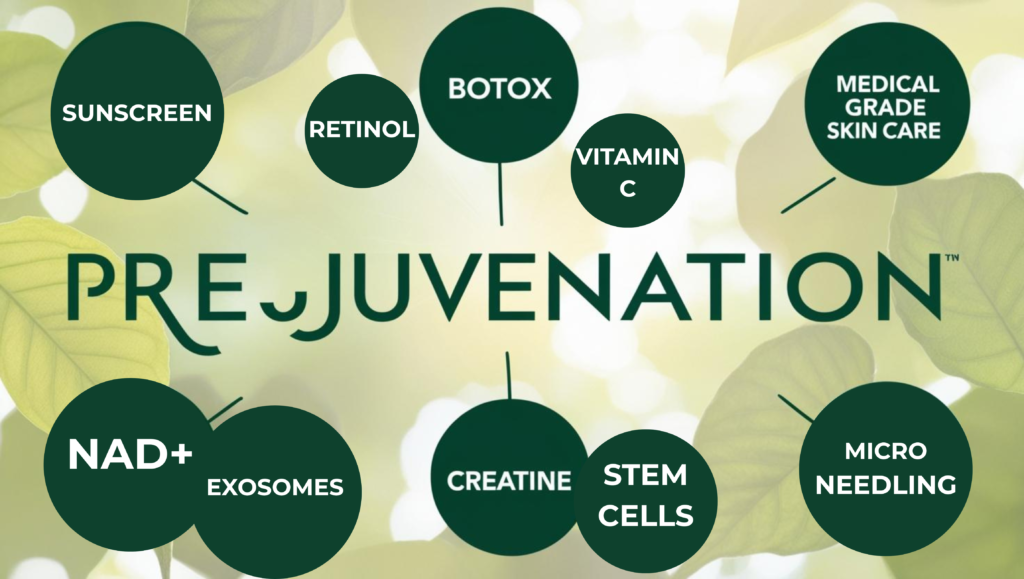The bottom line with aging well is to
Prejuvenation aims to have women who are younger start with healthy habits and skin care so that they age better. We know that slowing aging is achievable, where reversing aging is difficult. You are seeing evidence of this preventative aging catching on with young women at Sephora and growth of TikToks of #babybotox and more.
So what should you do?
Helping your skin be healthy involves multiple factors:
Collagen and elastin are what make your skin look good. As you age, you lose collagen and elastin and it becomes less organized. This translates into poorer looking skin. Collagen and elastin degrade faster after menopause (one of the reasons to consider HRT when you hit that age). These components affect skin TEXTURE, THICKNESS, and TONE.
How can you maintain it?
I am NOT a fan of many of the “biostimulators” which make collagen (like Sculptra, PLLA, Radiesse). This “collagen” they make is the collagen found in scar tissue, and I have found it prevents future fat graft survival. I liken it to throwing clay in the soil.
How do you prevent wrinkles?
Botox is the simple answer. Botulinum toxins block muscle movements, like the forehead, the corrugators (the “11” between the brows), the crows feet, neck bands, the frownies, bunny lines on the nose, mouth wrinkles, and more. They are super effective. (Of course do all of the skin health things as well)
But when do you need to start? Baby botox? “Preventative botox”?
I am not a believer in baby botox. If you have no wrinkle there at rest (when you aren’t moving your facial muscles), save your money. Spend money on things to improve your skin at a cellular level- topical medical grade products, microneedling, NAD, etc.
Starting at 20 won’t keep your skin any better than if you wait until you see some kind of wrinkle at rest. So if you start at 20 even though you have no visible wrinkles, and someone else starts at 30, you would be equal at 30.
Once you start to form fine lines, THEN it is a good idea to start. What you do not want is to wait until your lines are deep. If a line is deep enough, it actually thins the skin in the line and the crease cannot be fully reversed.
How often? The goal is to keep the wrinkles at bay. Everyone is a little different, but usually injections are done every 3-6 months. As you age, your skin quality worsens and your facial volume wanes, so you may need to do Botox more often.

There are things you can do to improve every single cell in your body. This is the essence of Biohacking, where you try to slow the faults that accrue in your cells over time. Oxidative stress, DNA mutations and errors, telomeres shortening, mitochondria not functioning as well. This aging of the cell is called CELL SENESCENCE, and addressing it is the key to antiaging and longevity.
I agree with this. I am very interested in biohacking, and how to slow cellular aging. And as a plastic surgeon who wants you to age better? Healthy bodies look better. What works for this?
DON”T SMOKE. This includes vaping, pot, edibles (THC is atherosclerotic). Just like the things above improve you at a cellular level, smoking hurts every body system.
SHOW THE SCIENCE. There are tons of snake oil treatments out there, and those in biohacking can be the worst offenders, showing you false images and data that” it works.” Where are you getting the information? If it is TikTok, an influencer, or a non-doctor advisor, please check a reputable site before you decide on anything.
See my page on whole body care – Healthspan + Longevity
PREVENTION is the key to pigmentation. What causes pigment?
What do I recommend?
SUNSCREEN. I love a mineral sunscreen. Use it daily. Wear hats. Wear surf shirts. Get your Vitamin D on your legs. Most skin cancers occur on the head and neck, followed by arms and hands. These are also the areas of the most visible photodamage. Protect them.
NIACINAMIDE. This antioxidant is great for pigmentation, and it also improves the quality and texture of the skin, lowers risk for skin cancers, and more.
ADDRESS EARLY. If I see someone with well established pigmentation, it is hard to reverse, particularly if it is old. Fresh injuries with pigment changes are more likely to improve.
Be objective.
Before you start a program, come in to do a full skin care visit with our nurse, Meghan Douglass. This involves looking at what you have done, what you are currently doing, and taking a Vectra 3D image to really be able to see your face up close. Vectra can help you analyze:
Then when you start programs, like our medical grade skincare or microneedling, you can see if it working. We will take a photo after 3-6 months (you need time to see effects) and see the changes.